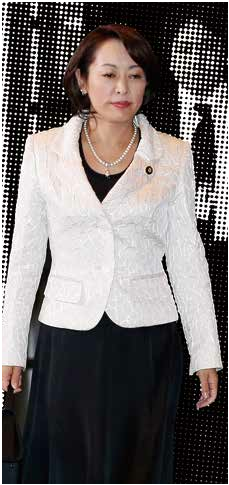Issue:
PM Abe’s “Womenomics” policies may be more than platitudes, but he’ll have to shake up the culture if they are going to make a difference



My friend Noriko Sato, a TV reporter for Fukuoka-based RKB Mainichi Broadcasting, is a meticulous planner. When she became pregnant some three years ago, she looked into what kind of childcare support she could expect from the local municipality. She was lucky.
When she returned to work after her year of child-rearing leave, Sato, 37, was assigned to an even busier beat as a court reporter. But she’s been able to handle it, having put her daughter Sara in a non government authorized day-care center, and turning to her neighbors when she and her medical doctor husband have scheduling problems. The Ministry of Health, Labor, and Welfare provides a family sup-port system in which trained members of the local community provide some child care while parents are working.
“You have to really keep up-to-date with the kind of support you can receive if you want to manage your work and child rearing at the same time,” says Sato. “The good thing is that Sara is more socially skilled thanks to her day-care experience and her interaction with our neighbors.”
Unlike my friend Sato, more than 60 percent of Japanese women now quit their jobs after giving birth, mostly because they cannot find or receive enough support to enable them to keep working while raising their children.
It’s something that will have to change if the prime minister’s program of Abenomics is to succeed. “Womanomics,” or capitalizing on the female workforce, is one of the pillars of his economic policies, simply because Japan can no longer afford to have half of the population out of the work force at a time when the nation is suffering from a declining population and snowballing social welfare costs.
In order to halt the female brain and work drain, Abe hopes to extend childrearing leave from the current 18 months to three years and solve the day-care shortage, removing thousands of children from the present waiting list.
But listening to my successful working mother friends, including my reporter friend, a chief credit analyst at one of the biggest global banks and a university lecturer, I cannot help but wonder whether Japanese women give up on their careers because the society cannot provide much support, or because the society doesn’t offer jobs rewarding enough to make them want to keep it at any cost.
According to a survey by the labor ministry, one out of three women between 15 and 39 want to be homemakers, while four out of five men want their wives to work. Maybe some women decide to become stay-at-home moms because the effort to keep their jobs is so cumbersome and costly. But many women might feel discouraged simply because Japan has failed to produce role models who show their peers that they can have both, if not everything.
THIS COUNTRY NEEDS TO ACCEPT DIVERSITY IN GENDER, AGE, RACE, NATIONALITY, MARITAL STATUS AND SEXUAL ORIENTATION
My views might be biased. I am a 35-year-old single woman with no children, husband or boyfriend, and I have no prospects to get married or pregnant any time soon. I am a “loser woman” according to the best-selling book called Make Inu no Toboe (“Loser women cry sour grapes”). But even if I ever get married and have children, I will never give up my career.
This is partly because I grew up in a family where both of my parents worked. My 63-year-old mother still works as a Japanese college administrator while my 68-year-old father retired several years ago. While I was growing up, my mother encouraged me to be professionally ambitious and told me to keep my job at any cost. She convinced me that a woman can manage both a family life and a professional life if that’s what she chooses to do.
That’s not to say that I haven’t seen her struggle, especially when I was in elementary school. Because I was rarely sick, she didn’t take days off to take care of me. But teachers at my school, an all-girls private school, often chastised her for not attending parents’ day. On the contrary, I was proud of my mother, and I always blamed my school for holding events during daytime on weekdays, when it is impossible for a working professional to attend.
I understand that my mother and my high-powered female friends are a minority in Japanese society. They are also relatively better-positioned financially, motivated and work for big enterprises that have the great benefits to make it all happen. Such big business enterprises account for only 0.3 percent of Japanese companies, and many small-to-mid-sized enterprises cannot afford to keep women on child-care leave on their payrolls or provide flexible working hours.
For example, a college friend worked for a mid-sized catalog retailer, where she had a responsible position in charge of catalog production. After the birth of her first son, however, she lost her full-time status and was forced to become a contract worker with much less pay. Recently, she told me that she chose to become a stay-home mom and accompany her husband to Luxembourg rather than keep working in the less-rewarding environment.
Some women even suffer discrimination from their female peers. A working mother I interviewed for a story a couple months ago confessed that she was thinking of leaving the company where she was working as a systems engineer because the female president of the company, single with no children, constantly criticized her for working shorter hours, even though it was permitted, according to the company rulebook.
The fact that problems are not limited to the private sector does not bode well for government progress. Masako Mori, state minister in charge of measures for the declining birthrate and gender equality, told me even the government lacks midcareer female public servants on a career track as they are forced to quit their jobs when their spouses are posted overseas.
If this is the way of the world even in the public sector, where women have relatively better working conditions, it’s doubtful that Japan will be able to achieve its goal to raise the percentage of female managers in the private sector to 30 percent across the board by 2020.
Abe likes to tout his pick of more women for government posts to illustrate how he acts on his pledges. Indeed, Abe tapped Seiko Noda, 52, as the first female chairperson of the LDP’s General Council, and named Sanae Takaichi, 52, as the first woman to lead the party’s policy research section. While those are important steps, the women are supported by male subordinates who are more politically experienced and some of my Japanese reporter colleagues say they are the ones doing the real work.
I do not think we can say Japan has really changed unless we see some female bureaucrats becoming vice ministers at the powerful and often masculine ministries like finance, defense and the foreign ministry. We cannot say Japan has finally turned the page unless we have a female governor at the Bank of Japan, like President Barack Obama’s pick of Janet Yellen as the first woman in U.S. history to head the Federal Reserve.
At the same time, I do understand that tapping unqualified females for executive positions solely for the sake having more women in management positions would undermine Japan’s efforts to capitalize on female power. They could easily fall prey to criticism if they fail to deliver some results in the male-dominated environment.
I also see shortcomings in Abe’s three year child-care leave vision. I do not think many women actually want to be away from work for three years, if they are serious about their careers. At Shiseido, a leading maker of beauty products, where females account for 80 percent of its domestic workforce, 75 percent of women returned to work after one year of childrearing leave. In today’s fast-paced working environment, it is almost impossible for women to keep up with their career if they are away from work for three years.
If the government really wants to develop the female workforce, they should not only solve the daycare shortage but also make it more affordable. One way to do so is increase the number of caregivers or nannies, including special nannies for sick children, which could create multi billion yen business opportunities. Or they could expland the economic partnership agreement program to bring nurses from the Philippines or Indonesia to nannies.
The educational system has to change more to teach children that it is natural for the husband and wife to share the burden of house chores and child rearing. According to the labor ministry, Japanese men with children under 6 years old only spend an average of 39 minutes per day on child rearing. In order to improve this, Japanese companies and government have to find more efficient ways of working.
Lastly, what’s really missing from the picture is the lack of “single and successful” as a viable choices for women. I see many talented, attractive and successful women around me, yet unmarried women are still perceived by many as a failure. Let’s not suffocate them just because they are not married with children. This country needs to accept diversity in gender, age, race, nationality, marital status and sexual orientation.
I hope this country can offer a place where qualified and talented mothers can go up the corporate ladder without being considered liabilities; meanwhile, single successful single women should not have to feel they are not contributing to the society just because they are not married with children. As one of the latter cases, I want to continue to say, despite the pressure, “I am single . . . and fabulous.”
Ayako Mie is a staff writer covering politics for the Japan Times.

